Moncler Bundle
How Did a Small French Village Shape the Global Icon That is Moncler?
Journey back in time to 1952, where a humble beginning in the French Alps would give rise to the globally recognized Moncler SWOT Analysis. From its roots as a supplier of mountain gear, the Moncler brand has ascended to the pinnacle of luxury outerwear. This remarkable transformation showcases the brand's strategic evolution and its enduring appeal in the fashion world.
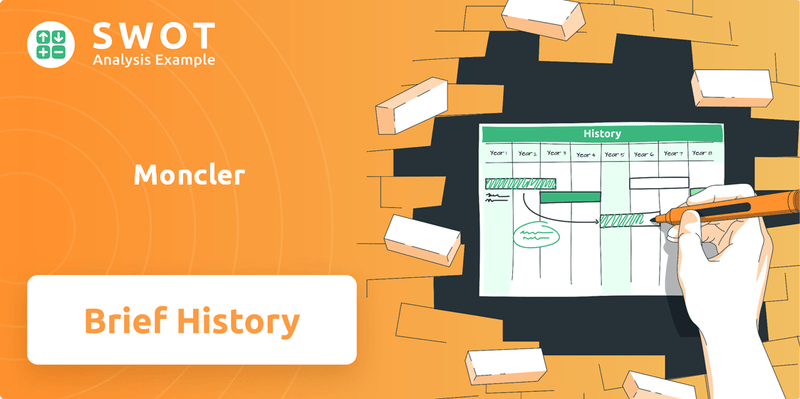
The Moncler company's story is one of remarkable growth, from its functional origins to its current status as an Italian fashion powerhouse. Its iconic down jackets have become synonymous with luxury and style, gracing runways and city streets alike. Understanding the brief history of Moncler jackets provides valuable insights into its enduring success and its continued innovation in the luxury outerwear market.
What is the Moncler Founding Story?
The story of the Moncler brand began in 1952, a testament to the vision of René Ramillon and André Vincent. Their combined expertise laid the groundwork for what would become a global luxury outerwear icon. The company's name itself is a nod to its roots, derived from Monestier-de-Clermont, a village nestled in the French Alps near Grenoble.
Ramillon, with his background in crafting mountain gear, and Vincent, bringing marketing and strategic insights, identified a clear need. They aimed to create durable, protective clothing for those working in the harsh mountain environment. This focus on practicality and functionality would define Moncler's early years.
The initial business model centered on utilitarian products designed to withstand the elements. This included quilted sleeping bags, tents, and padded garments. The first down jackets emerged from the necessity to protect the company's own factory workers from the extreme cold. These early jackets, constructed from nylon and filled with goose down, were simple yet effective, and weren't initially intended for the broader market.
Moncler's evolution from a practical gear manufacturer to a luxury brand is marked by several key moments.
- 1952: René Ramillon and André Vincent found the company.
- 1954: Introduction of the 'Karako' jacket, Moncler's first commercial down jacket, and collaboration with Lionel Terray.
- 1954: Moncler jackets equip the Italian K2 expedition, boosting the brand's reputation.
A pivotal moment arrived when French mountaineer Lionel Terray recognized the potential of Moncler's products. In 1954, Moncler launched the 'Karako,' its first down jacket made for commercial sale, directly influenced by Terray's input. This collaboration, resulting in the 'Moncler pour Lionel Terray' range, shifted Moncler towards becoming a technical outfitter for elite mountaineers. That same year, Moncler down jackets were chosen to outfit the Italian expedition to K2, further cementing the brand's reputation for high-performance gear.
Moncler SWOT Analysis
- Complete SWOT Breakdown
- Fully Customizable
- Editable in Excel & Word
- Professional Formatting
- Investor-Ready Format
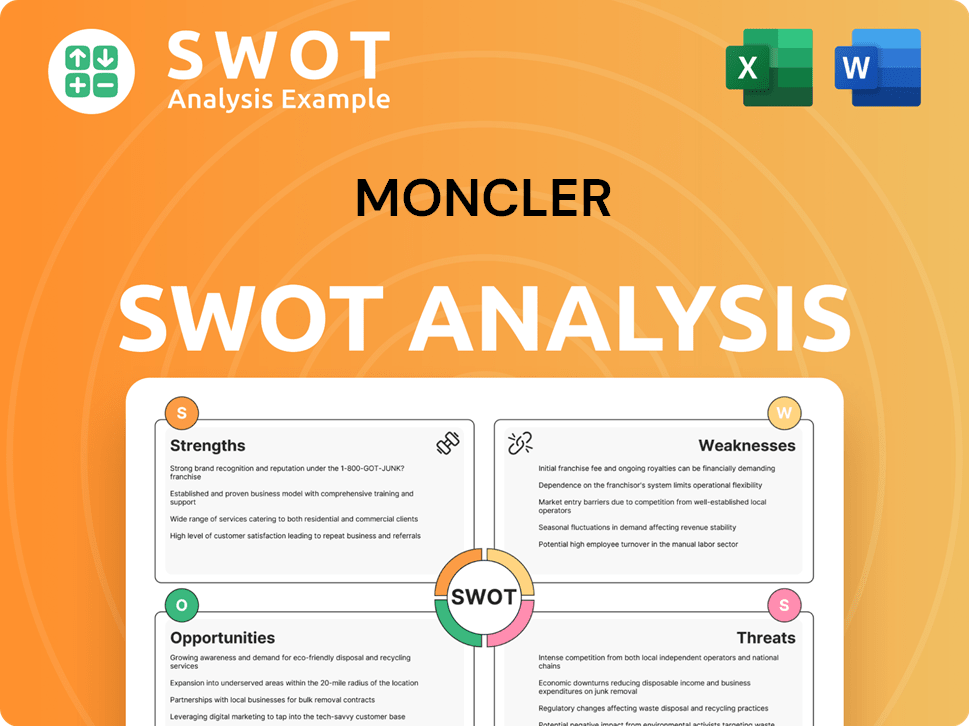
What Drove the Early Growth of Moncler?
The early growth of the Moncler company was significantly shaped by its association with mountaineering and expeditions. This period established the Moncler brand's reputation for quality and functionality in extreme conditions, solidifying its place in the outdoor apparel market. A pivotal moment came with its involvement in the 1968 Grenoble Winter Olympics, which boosted its international recognition.
Moncler's initial success was built on equipping mountaineering expeditions. The brand provided gear for the Italian expedition to K2 in 1954, the French expedition to Makalu in 1955, and Lionel Terray's expeditions in Alaska in 1964. These early partnerships were crucial for establishing the brand's credibility and testing its products in harsh environments. This focus on functionality set the stage for the Moncler brand's future.
In 1968, Moncler became the official supplier to the French downhill ski team for the Grenoble Winter Olympic Games. This sponsorship was a major turning point, significantly increasing the brand's visibility. The exposure helped Moncler gain international recognition, transforming its jackets into symbols of sportiness and elegance. This period marked a shift towards broader appeal.
By the 1980s, Moncler began evolving from a purely functional brand to a fashion statement. Down jackets became iconic, especially among youth in Milan. However, this transition also brought challenges, including frequent ownership changes. The brand struggled to compete with new outdoor apparel brands that invested heavily in research and development, while Moncler remained anchored in older materials and aesthetics.
In 2003, Remo Ruffini acquired Moncler, initiating a profound transformation. Ruffini repositioned the brand as a global luxury player, expanding its product lines and targeting a more upscale market. This strategic shift involved refining the brand's image and distribution strategy, leading to significant growth. The company's mission, vision, and core values are detailed in this article about Mission, Vision & Core Values of Moncler.
Moncler PESTLE Analysis
- Covers All 6 PESTLE Categories
- No Research Needed – Save Hours of Work
- Built by Experts, Trusted by Consultants
- Instant Download, Ready to Use
- 100% Editable, Fully Customizable
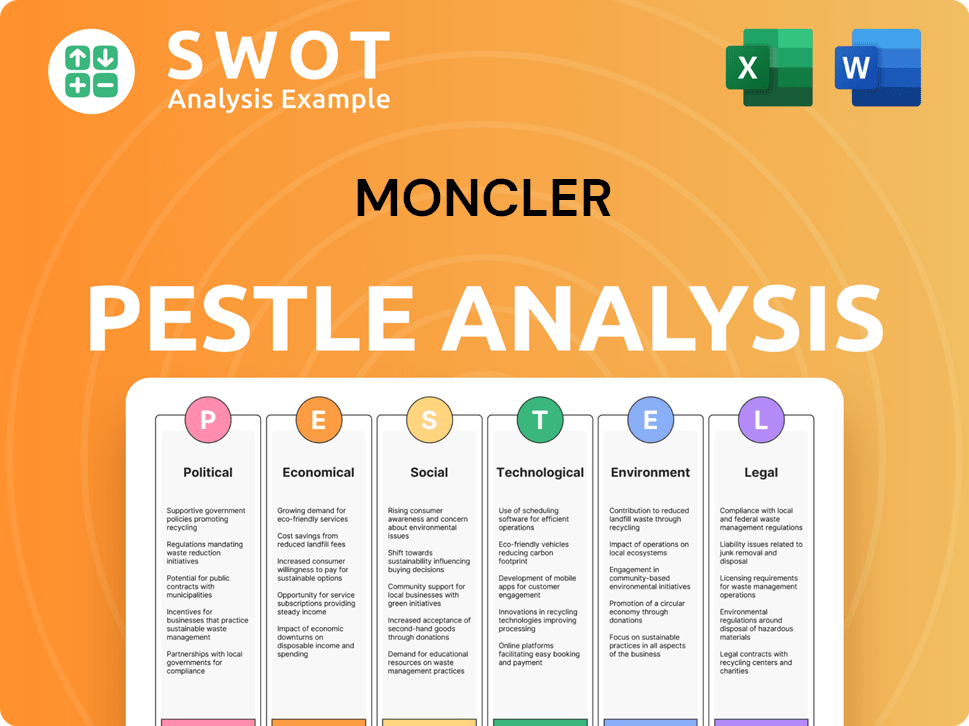
What are the key Milestones in Moncler history?
The Moncler history is a story of innovation, strategic pivots, and adaptation within the luxury outerwear market. From its origins as a supplier of functional gear to its evolution into a global luxury brand, Moncler's journey is marked by significant milestones and strategic decisions.
| Year | Milestone |
|---|---|
| 1952 | Moncler was founded in Monestier-de-Clermont, France, initially producing quilted sleeping bags and tents. |
| 1954 | Moncler supplied its down jackets to the Italian expedition that ascended K2. |
| 1968 | Moncler became the official supplier for the French downhill ski team at the Grenoble Winter Olympics, solidifying its reputation. |
| 2003 | Remo Ruffini acquired Moncler, initiating a comprehensive rebranding and strategic shift towards luxury. |
| 2018 | Moncler launched Moncler Genius, a collaborative project involving multiple designers to reinterpret the brand's identity. |
| 2020 | Moncler acquired Stone Island, expanding its portfolio into luxury sportswear. |
Moncler's innovations have been central to its success, particularly in the realm of luxury outerwear. The development of lightweight, down-filled jackets was a foundational innovation, providing warmth and protection for mountaineers and, later, a broader audience.
The initial innovation was the creation of down-filled jackets that were both lightweight and highly insulating, essential for extreme conditions. This technology set the stage for the brand's reputation for quality and performance.
Moncler Genius, launched in 2018, revolutionized the brand's approach to product development through frequent collaborations with various designers. This initiative fostered a hub of co-creation, spanning art, design, entertainment, music, sport, and culture.
Moncler continues to explore innovative materials to enhance the performance and aesthetics of its products. This includes advancements in down sourcing and the use of high-tech fabrics.
Expanding beyond its core outerwear, Moncler has diversified its product lines to include knitwear, footwear, leather goods, and accessories. This diversification broadens the brand's appeal and revenue streams.
Moncler has focused on enhancing its retail presence through strategic store locations and digital channels. This approach aims to create an immersive brand experience and cater to a global customer base.
Moncler is increasingly focused on sustainability, including responsible sourcing of materials and reducing its environmental impact. This commitment is becoming increasingly important to consumers.
Despite its successes, the
Moncler's business is significantly influenced by market fluctuations and macroeconomic conditions. The company must adapt to changing consumer behaviors and economic shifts to maintain its performance.
The company's reliance on the Chinese market exposes it to potential impacts from geopolitical tensions and economic slowdowns. Moncler must diversify its market presence to mitigate these risks.
The luxury outerwear market is highly competitive, with established brands and new entrants vying for market share. Moncler must continue to innovate and differentiate itself to stay ahead.
Moncler invests significantly in managing cyber risks and ensuring the availability of high-quality raw materials, such as down, through a multisourcing strategy. This is crucial for maintaining product quality and brand reputation.
Moncler must carefully manage its brand image and distribution to maintain its exclusivity and appeal to luxury consumers. This involves strategic pricing, limited distribution, and curated brand experiences.
Consumer preferences are constantly evolving, with a growing emphasis on sustainability, ethical sourcing, and personalization. Moncler must adapt its products and marketing strategies to meet these demands.
Moncler Business Model Canvas
- Complete 9-Block Business Model Canvas
- Effortlessly Communicate Your Business Strategy
- Investor-Ready BMC Format
- 100% Editable and Customizable
- Clear and Structured Layout
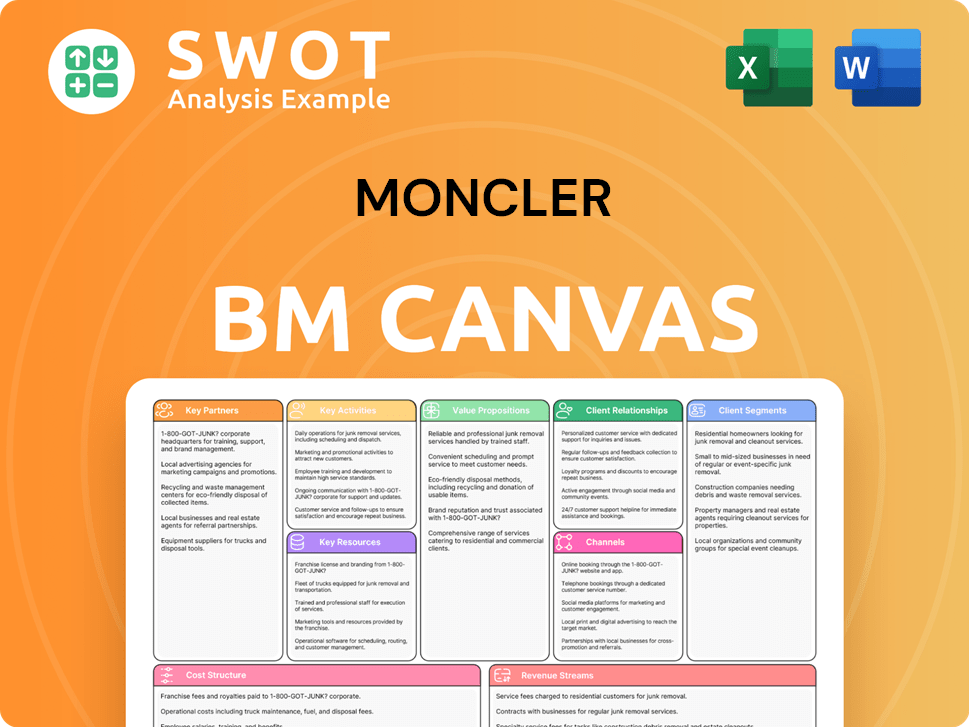
What is the Timeline of Key Events for Moncler?
The Moncler history is a narrative of strategic shifts and expansions, from its origins in the French Alps to its current status as a global luxury brand. Founded in 1952 by René Ramillon and André Vincent, the company initially produced equipment for workers before evolving into a fashion icon. Key milestones include supplying the French ski team, entering urban fashion in the 1980s, and the pivotal acquisition by Remo Ruffini in 2003, which repositioned the brand. Further expansions included launching haute couture and menswear collections, and the 2020 acquisition of Stone Island, forming the Moncler Group. The brand's evolution has been marked by innovation, collaborations, and a strong financial performance, solidifying its position in the luxury outerwear market.
| Year | Key Event |
|---|---|
| 1952 | René Ramillon and André Vincent founded the company in Monestier-de-Clermont, France. |
| 1954 | The 'Karako,' Moncler's first commercial down jacket, was introduced. |
| 1968 | Moncler became the official supplier to the French downhill ski team for the Grenoble Winter Olympic Games. |
| 1980s | The brand entered urban fashion, becoming an iconic garment for youth. |
| 2003 | Remo Ruffini acquired Moncler, initiating its repositioning as a luxury brand. |
| 2006 | Moncler Gamme Rouge, a haute couture collection for women, was launched. |
| 2010 | Moncler Grenoble, a technical collection for skiing and après-ski wear, was introduced. |
| 2013 | Moncler was listed on the Milan Stock Exchange. |
| 2018 | Moncler Genius, a collaborative initiative, was launched. |
| 2020 | The company acquired Stone Island, forming the Moncler Group. |
| 2024 | Moncler Group's consolidated revenues surpassed €3.1 billion. |
| Q1 2025 | Moncler Group reported consolidated revenues of €829 million. |
Moncler anticipates mid-single-digit growth in its direct-to-consumer channel in 2025. The company is focusing on operational flexibility and strategic marketing to drive brand development. This includes adapting to the current global economic climate.
The company is emphasizing operational flexibility in its supply chain, with a production adjustment capacity of approximately 10%. This ensures the ability to respond to market changes and maintain efficiency. They are also planning higher marketing expenditure.
Moncler is evolving its Moncler Genius platform into a co-creation platform, which aims to bring new energy to the brand. This initiative is designed to redefine luxury and attract new customers. The brand is focused on sustainable growth and community engagement.
In Q1 2025, the Moncler Group reported consolidated revenues of €829 million, with a 1% increase at constant exchange rates. The brand's financial health is supported by solid growth in the DTC channel for both Moncler and Stone Island, despite challenging macroeconomic conditions.
Moncler Porter's Five Forces Analysis
- Covers All 5 Competitive Forces in Detail
- Structured for Consultants, Students, and Founders
- 100% Editable in Microsoft Word & Excel
- Instant Digital Download – Use Immediately
- Compatible with Mac & PC – Fully Unlocked
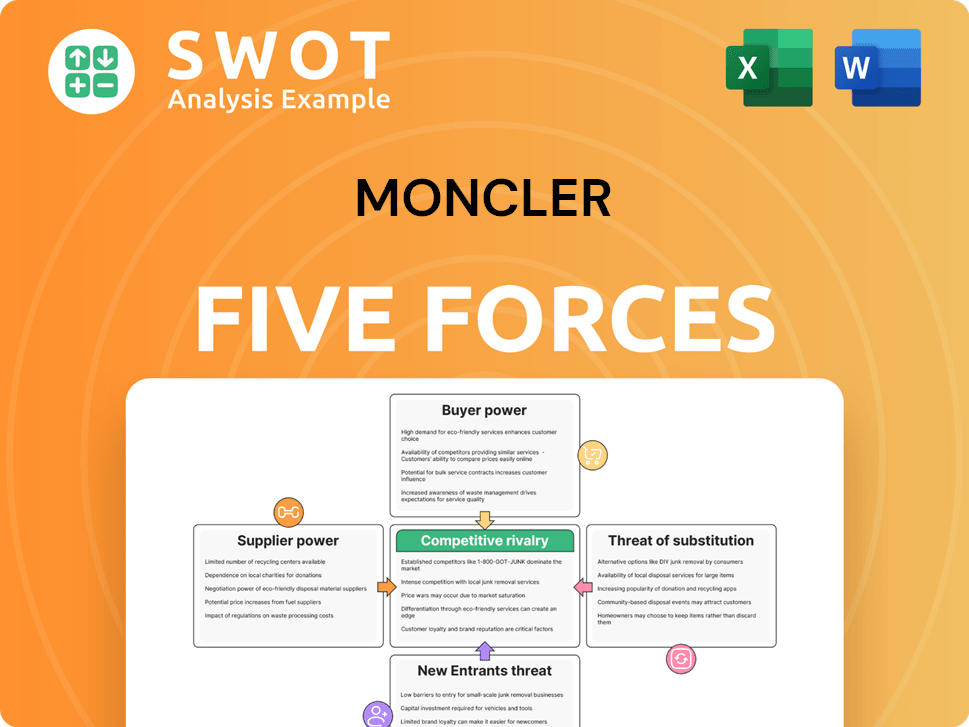
Related Blogs
- What is Competitive Landscape of Moncler Company?
- What is Growth Strategy and Future Prospects of Moncler Company?
- How Does Moncler Company Work?
- What is Sales and Marketing Strategy of Moncler Company?
- What is Brief History of Moncler Company?
- Who Owns Moncler Company?
- What is Customer Demographics and Target Market of Moncler Company?
Disclaimer
All information, articles, and product details provided on this website are for general informational and educational purposes only. We do not claim any ownership over, nor do we intend to infringe upon, any trademarks, copyrights, logos, brand names, or other intellectual property mentioned or depicted on this site. Such intellectual property remains the property of its respective owners, and any references here are made solely for identification or informational purposes, without implying any affiliation, endorsement, or partnership.
We make no representations or warranties, express or implied, regarding the accuracy, completeness, or suitability of any content or products presented. Nothing on this website should be construed as legal, tax, investment, financial, medical, or other professional advice. In addition, no part of this site—including articles or product references—constitutes a solicitation, recommendation, endorsement, advertisement, or offer to buy or sell any securities, franchises, or other financial instruments, particularly in jurisdictions where such activity would be unlawful.
All content is of a general nature and may not address the specific circumstances of any individual or entity. It is not a substitute for professional advice or services. Any actions you take based on the information provided here are strictly at your own risk. You accept full responsibility for any decisions or outcomes arising from your use of this website and agree to release us from any liability in connection with your use of, or reliance upon, the content or products found herein.